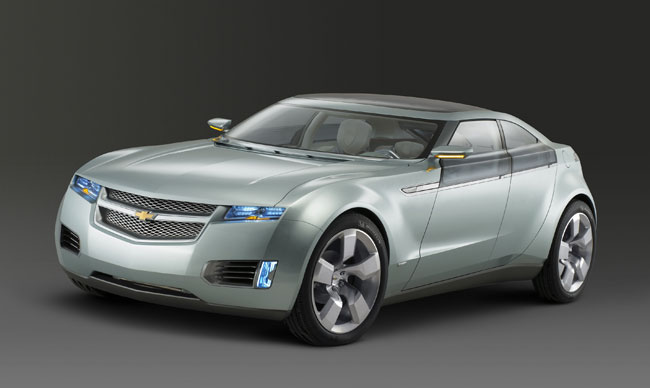
Don Anair is research and deputy director for the Clean Vehicles program at UCS. Heis an engineer with expertise on diesel, hybrid and battery electric vehicles and related policies. This article is adapted from a post to the UCS blog The Equation. Anair contributed this article to Live Science's Expert Voices: Op-Ed & Insights.
Plug-in electric vehicles (EVs) posted record sales numbers in August, with the Chevy Volt and Nissan LEAF both boasting their best sales month ever.
This is good news for a technology that is an important part of getting the United States on track to cut oil use in half and tackle global warming.
As more EVs hit the streets, a clearer picture is emerging of the plug-in car market. The news is good on this front too: while California continues to lead the pack, the data also show that consumer interest in EVs is spreading well beyond the Golden State.
From coast to coast, and most everywhere in between
Recent data released by Polk confirms that the top markets for plug-in cars are still on the east and west coasts, where five metropolitan areas collectively account for just over half of plug-in sales. However, some equally interesting data from Nissan on the top 15 markets for sales of the LEAF reveals what may be a more surprising trend: EVs are hitting the road across the country, with sales increasing in cities like Denver, St. Louis and Dallas.
So what does the rollout of EVs across the country mean for carbon emissions? I was curious how the top EV sales markets matched up with the Union of Concerned Scientists' evaluation of emissions by region in our "State of Charge" analysis.

In that analysis we found EVs have lower emissions during use than the average compact gasoline vehicle everywhere in the U.S., and in many areas are much better than even the most efficient gasoline hybrids.
Sign up for the Live Science daily newsletter now
Get the world’s most fascinating discoveries delivered straight to your inbox.
Turns out more than half (eight) of the top 15 cities (and four of the top five) for LEAF sales are in electricity grid regions that scored a "BEST" — regions where, when it comes to charging an EV on the electricity grid, global warming emissions are much lower than even the best gasoline-only hybrids out there.
Three of the top 15 cities are in "GOOD" regions, where EVs produce global warming emissions similar to the most efficient non-hybrid gasoline vehicles available (30 to 40 mpg). While an efficient hybrid gasoline vehicle might have lower global warming emissions than an EV today in these regions, the climate benefits of driving on electricity have the potential to grow over time as the electricity grid gets cleaner.
Benefits of renewable energy standards and EV deployment
Denver is a great example of a city that is investing in both EVs and renewable energy, driven by strong state policies, which means that EVs being sold in Colorado today will get cleaner over their lifetime.
One recent study by the Southwest Energy Efficiency Project (SWEEP) looked at how EV emissions in Colorado are likely to change in the coming years. The study found that global warming emissions of a 2013 model-year EV in Colorado are already slightly lower than a 28 mpg gasoline vehicle when charged on today's Colorado electricity grid mix. The study also found that as early as 2020, the same 2013 EV would be producing 40-percent less global-warming emissions than a 28 mpg gasoline vehicle due to Colorado's plans for cleaner electricity.
However, it is important to note that the 40-percent reduction assumes the marginal grid mix, which is the mix of power plant types (natural gas, coal, renewables, etc) that is expected to meet new electricity demand from the growing use of EVs. Using the average grid mix, which is the mix of power plants that is expected to meet all electricity demand in Colo. in 2020, would show about a 25-percent reduction in emissions compared to today. Under either the average or marginal grid-mix assumptions, the emissions from an EV are expected to improve substantially by 2020 as a result of decreased coal use and increased use of renewables.
Also, in a previous blog, I looked at projections to 2025 to see how the changing electricity grid-mix is expected to impact emissions on a regional grid level. That analysis showed the Rocky Mountain Power Area (RMPA) grid region, of which Colorado is a part, getting cleaner as well, but at a slower rate. Because the grid region goes well beyond the state boundaries, looking at state-specific electricity mixes, as the SWEEP study does, gives a clearer picture of the impact of state renewable-energy policies on state level emissions.
EVs and clean electricity: A smart long-term investment
Investment in renewables by individual homeowners is part of the story as well. In California, 39 percent of EV owners surveyed by the California Center for Sustainable Energy had solar panels on their home. Similar data were not available for Colorado, but the results of a survey of LEAF customers by a Nissan dealer in Boulder, shared via email, showed 16 of 32 respondents had solar on their homes. Opportunities for EV owners to choose green power options from their utility is another route for electric vehicle owners to support more renewable energy to power their cars.
The expansion of electric vehicle sales across the country is an encouraging sign for the future of electric vehicles. What's happening in Colorado is just one example of how pairing investment in EVs and renewable energy can make a big difference for our climate.
This Op-Ed was adapted from"Good News for the Climate: Electric Vehicles Posting Record Sales Across the Nation"on the UCS blog The Equation. The views expressed are those of the author and do not necessarily reflect the views of the publisher. This version of the article was originally published on Live Science.











